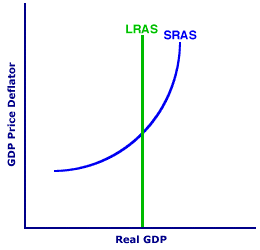
|
|
DECREASING RETURNS TO SCALE: A given proportionate increase in all resources in the long run results in a proportionately smaller increase in production. Decreasing returns to scale exists if a firm increases ALL resources -- labor, capital, and other inputs -- by 10%, and output increases by less than 10%. You might want to compare increasing returns to scale and constant returns to scale.
Visit the GLOSS*arama
|
|


|

|
                           SELF CORRECTION, INFLATIONARY GAP: The automatic process in which the aggregate market eliminates an inflationary gap created by a short-run equilibrium that is greater than full employment through increases in wages (and other resource prices). The self-correction mechanism is triggered by short-run resource market imbalances that are closed by long-run price flexibility. The self-correction process of the aggregate market also acts to close a recessionary gap with lower wages (and other resource prices). Self correction is seen as shifts of the short-run aggregate supply curve caused by changes in wages and other resource prices. The self-correction mechanism acts to close an inflationary gap with higher wages and a decrease in the short-run aggregate supply curve.With an inflationary gap, short-run equilibrium real production is greater than full-employment real production, meaning resource markets have shortages. In particular, labor is overemployed. Self correction is the process in which these temporary imbalances are eliminated through flexible prices as the aggregate market achieves long-run equilibrium. The key to this process is that changes in wages and other resource prices cause the short-run aggregate supply curve to shift. | Closing An Inflationary Gap |  |
The self-correction closure of an inflationary gap in the aggregate market can be illustrated using the exhibit to the right. The vertical axis measures the price level (GDP price deflator) and the horizontal axis measures real production (real GDP). This graph presents the two aggregate supply curves--long run and short run--but no aggregate demand curve. The vertical curve labeled LRAS is the long-run aggregate supply curve which marks full-employment real production. The positively-sloped curve labeled SRAS is then the short-run aggregate supply curve. The positioning of the aggregate demand curve and the point of intersection with the short-run aggregate supply curve indicates the inflationary gap. - Inflationary Gap: Click the [Inflationary Gap] button to reveal this output gap. With an inflationary gap, short-run equilibrium real production is greater than full-employment real production, meaning resource markets have shortages, and in particular labor is overemployed.
- Closing the Gap: In the long-run, this inflationary gap is closed with higher wages and a decrease in short-run aggregate supply. To illustrate this result, click the [Higher Wages] button. This button-clicking shifts the short-run aggregate supply curve to the left. A new equilibrium is achieved by the intersection of the new SRAS curve and the original AD curve. This intersection also coincides with the LRAS curve.
In the long run, wages and resource prices are flexible and they decline enough to eliminate imbalances in the resource markets. The result of rising wages (and other resource prices) is a boost in production cost. An increase in production cost causes a decrease in short-run aggregate supply, or a leftward shift of the SRAS curve.Note that the SRAS curve shifts leftward until it intersects BOTH the LRAS and AD curves at full-employment real production, which is long-run equilibrium. In particular, the new long-run equilibrium is at the full-employment level of real production. The SRAS curve absolutely MUST shift until this long-run equilibrium is reached. If the aggregate market does NOT reach long-run equilibrium, resource market imbalances persist, resource prices and production cost rise further, and the SRAS curve shifts more. However, once long-run equilibrium is reached, resource market imbalances are eliminated, resource prices and production cost do not change, and the SRAS curve does not shift any further.

Recommended Citation:SELF CORRECTION, INFLATIONARY GAP, AmosWEB Encyclonomic WEB*pedia, http://www.AmosWEB.com, AmosWEB LLC, 2000-2025. [Accessed: July 18, 2025].
Check Out These Related Terms... | | | | | | | |
Or For A Little Background... | | | | | | | | | | | | | | | | | | |
And For Further Study... | | | | | |
Search Again?
Back to the WEB*pedia
|



|

|
YELLOW CHIPPEROON
[What's This?]
Today, you are likely to spend a great deal of time searching the newspaper want ads trying to buy either a T-shirt commemorating the 2000 Olympics or a genuine fake plastic Tiffany lamp. Be on the lookout for telephone calls from former employers.
Your Complete Scope
This isn't me! What am I?
|

|
|
It's estimated that the U.S. economy has about $20 million of counterfeit currency in circulation, less than 0.001 perecent of the total legal currency.
|

|
|
"A winner is someone who recognizes his God-given talents, works his tail off to develop them into skills, and uses those skills to accomplish his goals. " -- Larry Bird, basketball player
|

|
AIC
Akaike's Information Criterion
|

|
|
Tell us what you think about AmosWEB. Like what you see? Have suggestions for improvements? Let us know. Click the User Feedback link.
User Feedback
|


|


